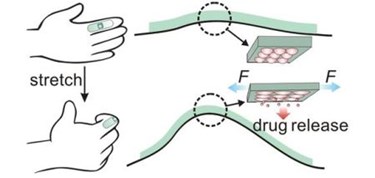Elastic Film Releases Drugs When Stretched

Scientists have developed a new material that releases drugs when it’s stretched. The technology could translate into wearable patches that painlessly deliver drugs as a person goes about their daily routine — without being wirelessly triggered.
The material is made from an elastic film covered with biocompatible microcapsules that are filled with drug-loaded nanoparticles, which leak into the microcapsule over time. When the material stretches, the surface area of the microcapsule increases, pushing the drug out onto the skin where it is absorbed.
“When the microcapsule is stretched from left to right, it is also compressed from bottom to top. That compression helps push the drug out of the microcapsule,” explained Yong Zhu, co-senior author of the study and associate professor of mechanical and aerospace engineering at North Carolina State University (NCSU), in a press release.
The team of developers spanned two universities, NCSU and University of North Carolina Chapel Hill, and published its findings in ACS Nano. In a study, researchers tested their design using anti-cancer medication on melanomas and anti-bacterial agents.
In an additional design, researchers incorporated microneedles that painlessly punctured the skin and could be used to deliver transcutaneous doses of insulin for patients with type 1 diabetes.
According to Zhen Gu, co-senior author and associate professor at NCSU and UNC-Chapel Hill’s joint biomedical engineering program, the team is just starting to work out the device’s potential applications. He speculated that burn patients, cancer patients, and patients with arthritis could all benefit.
“This could be used to release painkillers whenever a patient with arthritic knees goes for a walk, or to release antibacterial drugs gradually as people more around over the course of a day,” said Gu in the press release. He added that patches loaded with antibiotics and growth factors could promote wound healing.
The North Carolina project is one of many investigations currently underway to develop wearable drug-delivery patches. Last year, Nature reported that University of Austin scientists designed a stretchable material that could deliver drugs for Parkinson’s or epilepsy electronically, but that team is still working on how to miniaturize the power supply and data transmitter.
The advantage of the North Carolina design is that it is completely mechanical and requires no power supply, outside of the patient’s natural movements. Zhu commented that the design’s raw materials are relatively inexpensive, and he is confident that the project could be scaled up and still remain cost-effective.
Last March, Carmen Chan, a contributor for Millennium Research Group, commented on innovations in drug delivery as the device industry works to keep up with advances in pharmacotherapy. In many ways, the delivery method is as important as the drug itself, she noted, adding that many device manufacturers are inking long-term relationship agreements with drug developers during the preclinical stages of drug development.
The next generation of drug-delivery devices, said Chan, focuses on patient convenience and moving healthcare away from facilities and into the home.
